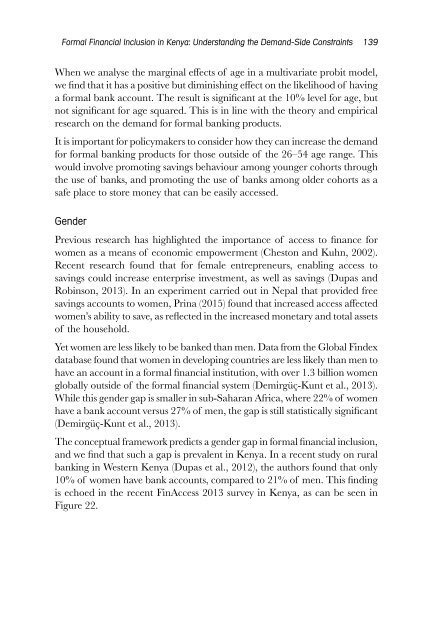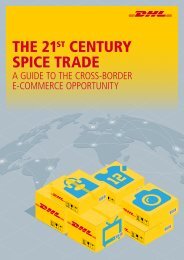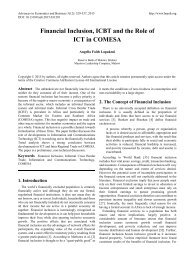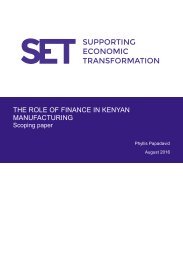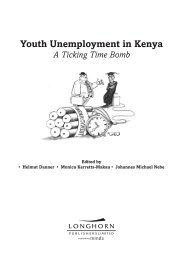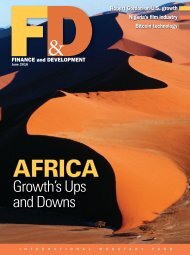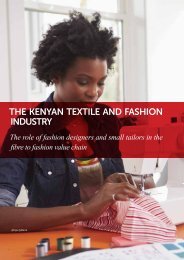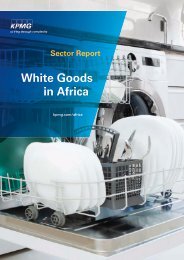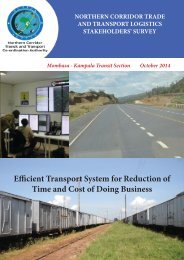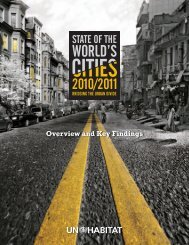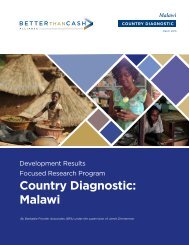in the 21st Century
hTOE305aYVW
hTOE305aYVW
Create successful ePaper yourself
Turn your PDF publications into a flip-book with our unique Google optimized e-Paper software.
Formal F<strong>in</strong>ancial Inclusion <strong>in</strong> Kenya: Understand<strong>in</strong>g <strong>the</strong> Demand-Side Constra<strong>in</strong>ts 139<br />
When we analyse <strong>the</strong> marg<strong>in</strong>al effects of age <strong>in</strong> a multivariate probit model,<br />
we f<strong>in</strong>d that it has a positive but dim<strong>in</strong>ish<strong>in</strong>g effect on <strong>the</strong> likelihood of hav<strong>in</strong>g<br />
a formal bank account. The result is significant at <strong>the</strong> 10% level for age, but<br />
not significant for age squared. This is <strong>in</strong> l<strong>in</strong>e with <strong>the</strong> <strong>the</strong>ory and empirical<br />
research on <strong>the</strong> demand for formal bank<strong>in</strong>g products.<br />
It is important for policymakers to consider how <strong>the</strong>y can <strong>in</strong>crease <strong>the</strong> demand<br />
for formal bank<strong>in</strong>g products for those outside of <strong>the</strong> 26–54 age range. This<br />
would <strong>in</strong>volve promot<strong>in</strong>g sav<strong>in</strong>gs behaviour among younger cohorts through<br />
<strong>the</strong> use of banks, and promot<strong>in</strong>g <strong>the</strong> use of banks among older cohorts as a<br />
safe place to store money that can be easily accessed.<br />
Gender<br />
Previous research has highlighted <strong>the</strong> importance of access to f<strong>in</strong>ance for<br />
women as a means of economic empowerment (Cheston and Kuhn, 2002).<br />
Recent research found that for female entrepreneurs, enabl<strong>in</strong>g access to<br />
sav<strong>in</strong>gs could <strong>in</strong>crease enterprise <strong>in</strong>vestment, as well as sav<strong>in</strong>gs (Dupas and<br />
Rob<strong>in</strong>son, 2013). In an experiment carried out <strong>in</strong> Nepal that provided free<br />
sav<strong>in</strong>gs accounts to women, Pr<strong>in</strong>a (2015) found that <strong>in</strong>creased access affected<br />
women’s ability to save, as reflected <strong>in</strong> <strong>the</strong> <strong>in</strong>creased monetary and total assets<br />
of <strong>the</strong> household.<br />
Yet women are less likely to be banked than men. Data from <strong>the</strong> Global F<strong>in</strong>dex<br />
database found that women <strong>in</strong> develop<strong>in</strong>g countries are less likely than men to<br />
have an account <strong>in</strong> a formal f<strong>in</strong>ancial <strong>in</strong>stitution, with over 1.3 billion women<br />
globally outside of <strong>the</strong> formal f<strong>in</strong>ancial system (Demirgüç-Kunt et al., 2013).<br />
While this gender gap is smaller <strong>in</strong> sub-Saharan Africa, where 22% of women<br />
have a bank account versus 27% of men, <strong>the</strong> gap is still statistically significant<br />
(Demirgüç-Kunt et al., 2013).<br />
The conceptual framework predicts a gender gap <strong>in</strong> formal f<strong>in</strong>ancial <strong>in</strong>clusion,<br />
and we f<strong>in</strong>d that such a gap is prevalent <strong>in</strong> Kenya. In a recent study on rural<br />
bank<strong>in</strong>g <strong>in</strong> Western Kenya (Dupas et al., 2012), <strong>the</strong> authors found that only<br />
10% of women have bank accounts, compared to 21% of men. This f<strong>in</strong>d<strong>in</strong>g<br />
is echoed <strong>in</strong> <strong>the</strong> recent F<strong>in</strong>Access 2013 survey <strong>in</strong> Kenya, as can be seen <strong>in</strong><br />
Figure 22.


